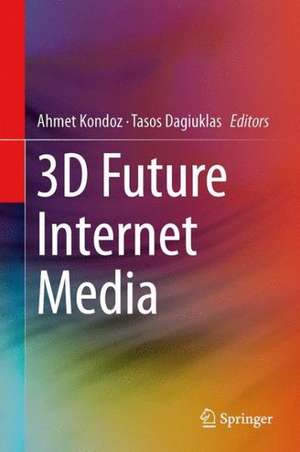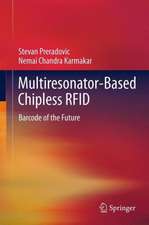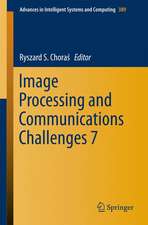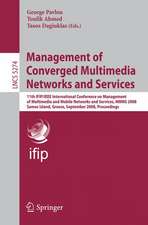3D Future Internet Media
Editat de Ahmet Kondoz, Tasos Dagiuklasen Limba Engleză Hardback – 12 noi 2013
The delivery of 3D media to individual users remains a highly challenging problem due to the large amount of data involved, diverse network characteristics and user terminal requirements, as well as the user’s context such as their preferences and location. As the number of visual views increases, current systems will struggle to meet the demanding requirements in terms of delivery of constant video quality to both fixed and mobile users.
ROMEO will design and develop hybrid-networking solutions that combine the DVB-T2 and DVB-NGH broadcast access network technologies together with a QoE aware Peer-to-Peer (P2P) distribution system that operates over wired and wireless links. Live streaming 3D media needs to be received by collaborating users at the same time or with imperceptible delay to enable them to watch together while exchanging comments as if they were all in the same location.
The volume provides state-of-the-art information on 3D multi-view video, spatial audio networking protocols for 3D media, P2P 3D media streaming, and 3D Media deliveryacross heterogeneous wireless networks among other topics. Graduate students and professionals in electrical engineering and computer science with an interest in 3D Future Internet Media will find this volume to be essential reading.
| Toate formatele și edițiile | Preț | Express |
|---|---|---|
| Paperback (1) | 786.00 lei 38-44 zile | |
| Springer – 23 aug 2016 | 786.00 lei 38-44 zile | |
| Hardback (1) | 955.25 lei 6-8 săpt. | |
| Springer – 12 noi 2013 | 955.25 lei 6-8 săpt. |
Preț: 955.25 lei
Preț vechi: 1164.93 lei
-18% Nou
Puncte Express: 1433
Preț estimativ în valută:
182.81€ • 188.60$ • 154.72£
182.81€ • 188.60$ • 154.72£
Carte tipărită la comandă
Livrare economică 04-18 martie
Preluare comenzi: 021 569.72.76
Specificații
ISBN-13: 9781461483724
ISBN-10: 1461483727
Pagini: 312
Ilustrații: VIII, 302 p. 154 illus., 114 illus. in color.
Dimensiuni: 155 x 235 x 20 mm
Greutate: 0.73 kg
Ediția:2014
Editura: Springer
Colecția Springer
Locul publicării:New York, NY, United States
ISBN-10: 1461483727
Pagini: 312
Ilustrații: VIII, 302 p. 154 illus., 114 illus. in color.
Dimensiuni: 155 x 235 x 20 mm
Greutate: 0.73 kg
Ediția:2014
Editura: Springer
Colecția Springer
Locul publicării:New York, NY, United States
Public țintă
ResearchCuprins
Chapter 1: Introduction.- Part I.- Chapter 2: 3D media representation and coding.- Chapter 3: Merging the real and the synthetic in augmented 3D worlds: A brief survey of applications and challenges.- Chapter 4: Multi-view acquisition and advanced depth map processing techniques.- Chapter 5: Object-based spatial audio: concept, advantages and challenges.- Part II.- Chapter 6: Transport Protocols for 3D Video.- Chapter 7: Media-Aware Networks in Future Internet Media.- Chapter 8: P2P Video Streaming Technologies.- Chapter 9: IP-based Mobility Scheme Supporting 3D Video Streaming Services.- Part III.- Chapter 10: Dynamic QoS Support for P2P Communications.- Chapter 11: Assessing the Quality of Experience of 3DTV and beyond -Tackling the multidimensional.- Chapter 12: Error Concealment Techniques in Multi-view Video Applications.- Part IV.- Chapter 13: 3D Robotic Surgery and Training at a Distance.- Chapter 14: Future of 3DTV broadcasting: the MUSCADE perspective.- Index.
Recenzii
From the book reviews:
“This book collects recent progress in various areas of the future 3D media internet. … Throughout the book, the authors provide easily understandable descriptions and explanations of the technical concepts and methods. … The potential beneficiaries are researchers or professionals and students who work in image coding, networking, and media.” (Huiyu Zhou, Computing Reviews, June, 2014)
“This book collects recent progress in various areas of the future 3D media internet. … Throughout the book, the authors provide easily understandable descriptions and explanations of the technical concepts and methods. … The potential beneficiaries are researchers or professionals and students who work in image coding, networking, and media.” (Huiyu Zhou, Computing Reviews, June, 2014)
Textul de pe ultima copertă
This book describes recent innovations in 3D media and technologies, with coverage of 3D media capturing, processing, encoding, and adaptation, networking aspects for 3D Media, and quality of user experience (QoE). The main contributions are based on the results of the FP7 European Projects ROMEO, which focus on new methods for the compression and delivery of 3D multi-view video and spatial audio, as well as the optimization of networking and compression jointly across the Future Internet (www.ict-romeo.eu).
The delivery of 3D media to individual users remains a highly challenging problem due to the large amount of data involved, diverse network characteristics and user terminal requirements, as well as the user’s context such as their preferences and location. As the number of visual views increases, current systems will struggle to meet the demanding requirements in terms of delivery of constant video quality to both fixed and mobile users.
ROMEO will design and develop hybrid-networking solutions that combine the DVB-T2 and DVB-NGH broadcast access network technologies together with a QoE aware Peer-to-Peer (P2P) distribution system that operates over wired and wireless links. Live streaming 3D media needs to be received by collaborating users at the same time or with imperceptible delay to enable them to watch together while exchanging comments as if they were all in the same location.
The volume provides state-of-the-art information on 3D multi-view video, spatial audio networking protocols for 3D media, P2P 3D media streaming, and 3D Media delivery across heterogeneous wireless networks among other topics. Graduate students and professionals in electrical engineering and computer science with an interest in 3D Future Internet Media will find this volume to be essentialreading.
The delivery of 3D media to individual users remains a highly challenging problem due to the large amount of data involved, diverse network characteristics and user terminal requirements, as well as the user’s context such as their preferences and location. As the number of visual views increases, current systems will struggle to meet the demanding requirements in terms of delivery of constant video quality to both fixed and mobile users.
ROMEO will design and develop hybrid-networking solutions that combine the DVB-T2 and DVB-NGH broadcast access network technologies together with a QoE aware Peer-to-Peer (P2P) distribution system that operates over wired and wireless links. Live streaming 3D media needs to be received by collaborating users at the same time or with imperceptible delay to enable them to watch together while exchanging comments as if they were all in the same location.
The volume provides state-of-the-art information on 3D multi-view video, spatial audio networking protocols for 3D media, P2P 3D media streaming, and 3D Media delivery across heterogeneous wireless networks among other topics. Graduate students and professionals in electrical engineering and computer science with an interest in 3D Future Internet Media will find this volume to be essentialreading.
- Describes the latest innovations in 3D technologies and Future Internet media
- Focuses on research to facilitate application scenarios such as social TV and high-quality, real-time collaboration
- Discusses QoE for 3D
Caracteristici
Describes the latest innovations in 3D technologies and Future Internet media Focuses on research to facilitate application scenarios such as social TV and high-quality, real-time collaboration Discusses QoE for 3D






















